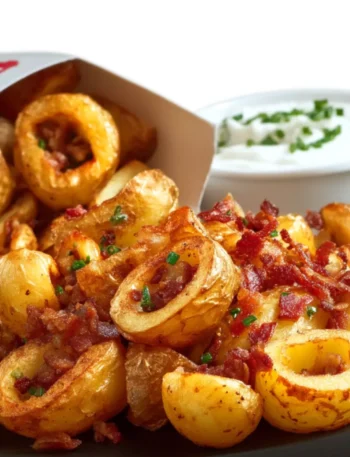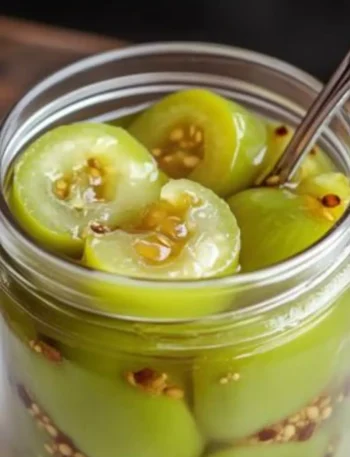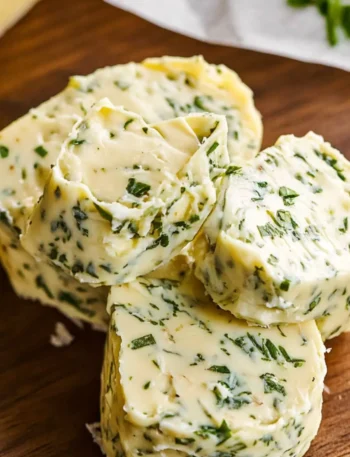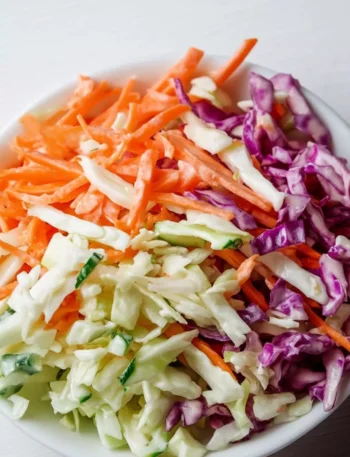Before we dive into the intricacies of baking crusty French bread rolls, let’s talk about what to pair with these delightful morsels. They’re not just bread; they’re a fantastic canvas for other flavors. You might consider a rich homemade soup, perhaps a classic French onion or a vibrant vegetable bisque. The rolls are perfect for sopping up broth.
Another splendid option is a simple charcuterie board. Picture this: crusty rolls next to a variety of cheeses, cured meats, olives, and a drizzle of balsamic reduction. It’s an invitation to the palate that invites everyone to grab a roll and create their own combination.

Lastly, let’s not forget about salads! A bright, zesty salad with lemon vinaigrette, full of crunchy vegetables, pairs beautifully with the dense, crispy texture of these rolls. Now, let’s jump into the wonderful world of crusty French bread rolls!
There’s something magical about the aroma of fresh bread. Baking crusty French bread rolls is an experience that connects you to centuries of culinary tradition. It transforms your kitchen into a haven of warmth and comfort. When I first set out to tackle these rolls, I quickly learned that the process is not just about the final product; it’s about the adventure of creating something so simple yet profoundly satisfying.
Picture yourself with flour dusting your countertop, the scent of yeast wafting through the air, and anticipation building as you await that perfect golden crust. The best part? These rolls can elevate any meal, making them a staple in my household. So, what makes crusty French bread rolls so special? Let’s unpack that!
What Are Crusty French Bread Rolls?
Crusty French bread rolls are characterized by their hard, crunchy exterior and soft, fluffy inside. They are often made using a simple mix of flour, water, yeast, and salt. The key to their crusty exterior lies in creating steam during the baking process, which gives them that lovely golden finish.
These rolls can be served with butter, used to hold your favorite sandwich fillings, or simply enjoyed on their own.
You will also like the following Appetizers recipes!
Why This Recipe Works
Baking, much like painting, demands certain foundational techniques.
1. The Right Flour Matters
Using unbleached all-purpose flour offers a sturdy structure without being too heavy. It strikes the perfect balance that allows you to achieve that delightful chewy interior.
2. Active Dry Yeast Is Key
The yeast is the magic ingredient. It ferments, releasing gas that makes the dough rise. Using active dry yeast ensures the rolls are airy and light.
3. Warm Water Activates Yeast
When mixed with warm water, yeast comes alive, kicking off the fermentation process. This first step is paramount for the dough’s rise.
4. A Hot Oven for Crust Creation
Baking at a high temperature produces steam. This steam forms a crispy crust while preserving that tender, fluffy inside. It’s essential for achieving the signature crusty texture.
Ingredients You’ll Need to Make This Dish
Before you start baking, gather these ingredients:
- 2 1/2 cups unbleached all-purpose flour
This type of flour provides the perfect texture and structure. - 1/2 teaspoon organic honey
A touch of sweetness helps activate yeast. - 1 teaspoon dried Italian herbs (optional)
For those who want an optional flavor boost. - 1 teaspoon active dry yeast
Vital for the fermentation process that creates light rolls. - 1 cup warm water (about 110°F)
An essential temperature to awaken the yeast. - 2 tablespoons olive oil
Adds richness and contributes to a tender texture. - 3/4 teaspoon fine sea salt
Enhances flavor balance.

How to Make Crusty French Bread Rolls
Ready to bring your kitchen to life with the aroma of fresh bread? Here’s a step-by-step guide for crafting these crusty rolls.
Step 1: Activate the Yeast
Start by combining the warm water and honey in a mixing bowl. Sprinkle the active dry yeast over the water and let it sit for about 10 minutes. You should see it begin to foam, indicating that the yeast is awake and ready to rise.
Step 2: Mix the Ingredients
Once the yeast is foamy, add the salt and olive oil to the mixture. Slowly incorporate the flour, one cup at a time. Mix until the dough comes together and pulls away from the sides of the bowl.
Step 3: Knead the Dough
Transfer the dough onto a lightly floured surface. Knead it for about 10 minutes until it becomes smooth and elastic. This step is vital for developing the gluten, which gives the rolls their texture.
Step 4: First Rise
Shape the dough into a ball and place it in a greased bowl. Cover it with a damp cloth and let it rise in a warm area for about an hour or until it doubles in size.
Step 5: Shape the Rolls
After the dough has risen, punch it down to release the air. Divide the dough into equal pieces. Shape each piece into a ball and place them on a baking sheet lined with parchment paper.
Step 6: Second Rise
Cover the rolls with a cloth and let them rise again for another 30 minutes. This second rise allows the rolls to become airy and light.
Step 7: Preheat the Oven
While the rolls are rising, preheat your oven to 450°F (230°C). If you have a baking stone or a cast iron skillet, place it in the oven to heat up as well.
Step 8: Create Steam
Right before placing the rolls in the oven, set a small oven-safe pan at the bottom of the oven. Pour hot water into it just after you put the rolls in. This steam will give you that desired crust.
Step 9: Bake
Bake the rolls for about 20-25 minutes or until they are golden brown. You can tap the bottom of a roll; if it sounds hollow, they are done.
Step 10: Cool and Enjoy
Remove the rolls from the oven and let them cool on a wire rack. This step helps maintain texture.
Tips & Tricks
- Don’t Rush the Rises: Give the dough enough time to rise. This affects the texture and flavor.
- Use a Kitchen Thermometer: Checking water temperature ensures the yeast is activated properly.
- Experiment with Flavors: Try adding herbs or spices to the dough for a unique twist.
- Steam is Your Friend: Always create steam for a perfect crust.
- Store Properly: If you have extras, store them to maintain their crunch and softness.
Nutrition Information
Crusty French bread rolls are a delightful addition to your diet. Nutritionally, one roll has approximately:
- Calories: 150
- Carbohydrates: 32g
- Protein: 4g
- Fat: 3g
- Fiber: 1g
These rolls can fit into a variety of meal plans if consumed in moderation.
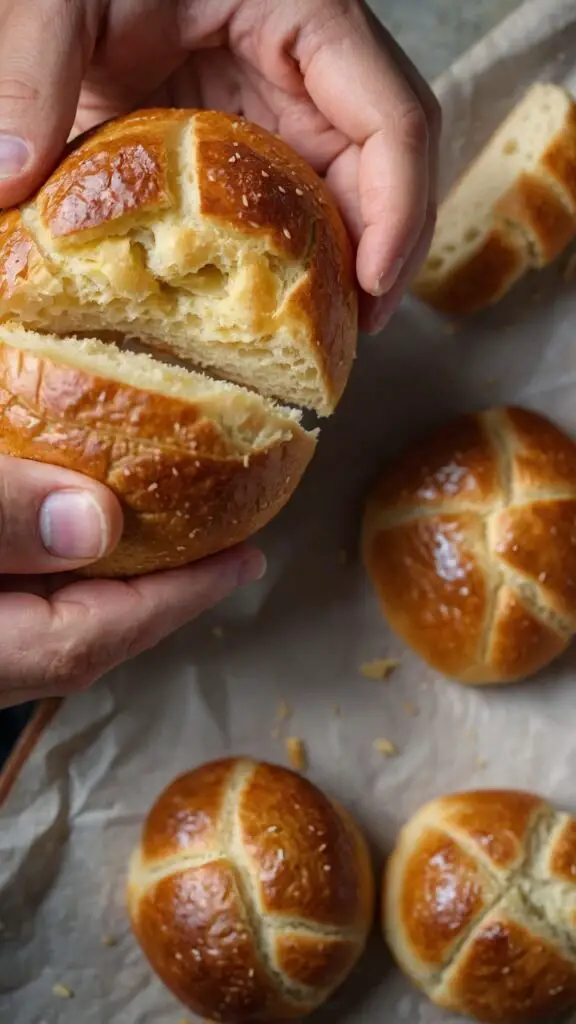
How Do You Store the Leftovers?
If you have leftover rolls (and that’s a big if), simply place them in a paper bag. Avoid plastic as it traps moisture, making the rolls soggy. They are best enjoyed fresh but can be kept for a day or two. You can also freeze them for longer storage; just thaw and reheat when you’re ready to enjoy.
What Sides Would Complement Crusty French Bread Rolls?
When serving crusty rolls, consider these side options:
- French Onion Soup: Nothing says comfort quite like a warm bowl of this classic soup. The rolls can be used to soak up every last drop.
- Mixed Green Salad: A fresh, crunchy salad with vinaigrette provides a balance to the rolls’ richness. Toss in some nuts or fruits for an exciting twist.
- Bruschetta: Top your slices of bread rolls with diced tomatoes, garlic, and basil. This appetizer is light and bright, making it a perfect match.
What Alternatives Can You Use for the Ingredients If They Are Not Present in Your Kitchen?
- Flour: If you run out of all-purpose flour, bread flour can work wonders. It has a higher protein content, creating a chewier texture.
- Active Dry Yeast: Instant yeast can be a quick substitute. You can skip the activation step.
- Olive Oil: Any neutral oil can take the place of olive oil. Canola or sunflower oil can work without affecting taste dramatically.
- Salt: Sea salt is wonderful, but table salt can definitely substitute in a pinch.
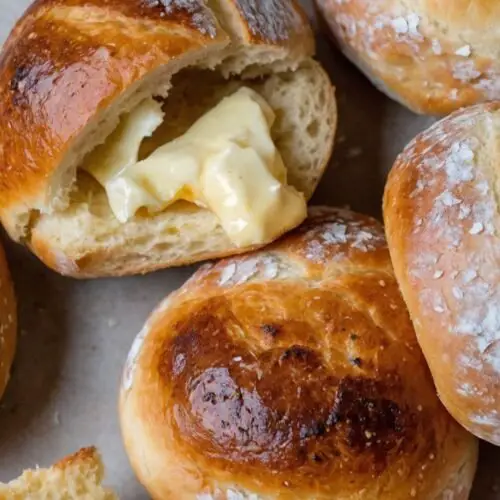
Crusty French Bread Rolls
Equipment
- Oven
Ingredients
- 2 1/2 cups unbleached all-purpose flour
- This type of flour provides the perfect texture and structure.
- 1/2 teaspoon organic honey
- A touch of sweetness helps activate yeast.
- 1 teaspoon dried Italian herbs optional
- For those who want an optional flavor boost.
- 1 teaspoon active dry yeast
- Vital for the fermentation process that creates light rolls.
- 1 cup warm water about 110°F
- An essential temperature to awaken the yeast.
- 2 tablespoons olive oil
- Adds richness and contributes to a tender texture.
- 3/4 teaspoon fine sea salt
- Enhances flavor balance.
Instructions
Step 1: Activate the Yeast
- Start by combining the warm water and honey in a mixing bowl. Sprinkle the active dry yeast over the water and let it sit for about 10 minutes. You should see it begin to foam, indicating that the yeast is awake and ready to rise.
Step 2: Mix the Ingredients
- Once the yeast is foamy, add the salt and olive oil to the mixture. Slowly incorporate the flour, one cup at a time. Mix until the dough comes together and pulls away from the sides of the bowl.
Step 3: Knead the Dough
- Transfer the dough onto a lightly floured surface. Knead it for about 10 minutes until it becomes smooth and elastic. This step is vital for developing the gluten, which gives the rolls their texture.
Step 4: First Rise
- Shape the dough into a ball and place it in a greased bowl. Cover it with a damp cloth and let it rise in a warm area for about an hour or until it doubles in size.
Step 5: Shape the Rolls
- After the dough has risen, punch it down to release the air. Divide the dough into equal pieces. Shape each piece into a ball and place them on a baking sheet lined with parchment paper.
Step 6: Second Rise
- Cover the rolls with a cloth and let them rise again for another 30 minutes. This second rise allows the rolls to become airy and light.
Step 7: Preheat the Oven
- While the rolls are rising, preheat your oven to 450°F (230°C). If you have a baking stone or a cast iron skillet, place it in the oven to heat up as well.
Step 8: Create Steam
- Right before placing the rolls in the oven, set a small oven-safe pan at the bottom of the oven. Pour hot water into it just after you put the rolls in. This steam will give you that desired crust.
Step 9: Bake
- Bake the rolls for about 20-25 minutes or until they are golden brown. You can tap the bottom of a roll; if it sounds hollow, they are done.
Step 10: Cool and Enjoy
- Remove the rolls from the oven and let them cool on a wire rack. This step helps maintain texture.
Notes
- Don’t Rush the Rises: Give the dough enough time to rise. This affects the texture and flavor.
- Use a Kitchen Thermometer: Checking water temperature ensures the yeast is activated properly.
- Experiment with Flavors: Try adding herbs or spices to the dough for a unique twist.
- Steam is Your Friend: Always create steam for a perfect crust.
- Store Properly: If you have extras, store them to maintain their crunch and softness.
Nutrition
Frequently Asked Questions
Can I use whole wheat flour?
Yes, you can substitute whole wheat flour, but you may want to adjust the water content slightly as it absorbs more moisture.
What can I add to the dough for flavor?
Herbs, garlic powder, or even grated cheese can be added for extra flavor. Just be mindful not to overdo it.
Can I use this dough for a loaf instead of rolls?
Absolutely! Shape the dough into a loaf and adjust the baking time, around 30-35 minutes usually suffices.
Is this recipe suitable for freezing?
Yes, these rolls freeze beautifully. Wrap them tightly in plastic wrap before storing them in the freezer.
Can I make these rolls gluten-free?
Using a gluten-free flour blend specifically designed for baking can work, but make sure to check the instructions for specific ratios.
How do I know when the rolls are done?
The rolls should have a golden color and sound hollow when tapped on the bottom. Checking with a thermometer for an internal temperature of 190°F is also a reliable method.
Conclusion
Baking crusty French bread rolls is a worthy endeavor. Once you bite into a freshly baked roll, with its robust crust and soft center, you’ll understand why this simple recipe deserves a spot in your kitchen.
With paired dishes like soups, salads, or an array of toppings, your crusty rolls can shine at any meal. So roll up your sleeves, gather your ingredients, and embark on this delightful baking journey! Trust me; the rewards are not just about taste—they’re about the memories you create along the way. Enjoy!

